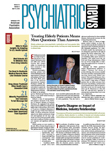Analysis of data from the Treatment for Adolescents With Depression Study (TADS) indicates that treatment with a selective serotonin reuptake inhibitor (SSRI) or a combination of an SSRI and cognitive-behavioral therapy are cost-effective at 12 weeks of treatment. The researchers concluded, however, that based on a standard cost-effectiveness measure, SSRI treatment is more cost-effective than combination therapy since the additional improvement came at a high cost.
The TADS study, sponsored by the national Institute of Mental Health to determine the best way to treat teenagers with major depression, earlier reported that therapy combining the SSRI fluoxetine with cognitive-behavioral therapy (CBT) produced better clinical outcomes than did placebo or either treatment alone.
At 12 weeks, 73 percent of patients in TADS receiving combination therapy, 62 percent of those receiving fluoxetine only, 48 percent of those receiving CBT alone, and 34 percent of those receiving placebo were considered treatment responders.
Over the 12-week study, patients on placebo accrued median costs of $841, those taking fluoxetine alone $942, patients on CBT alone $2,287, and those on a combination of the drug and CBT $2,832. Each category, however, had wide-ranging costs. For instance, placebo costs ranged from $109 to $23,838 per patient, and combination therapy cost between $390 and $15,292 per patient.
The study was posted on AJP In Advance on April 15 and will be published in the May print edition of the American Journal of Psychiatry.
In an editorial accompanying the article, Grayson Norquist, M.D., professor and chair of the Department of Psychiatry and Human Behavior at the University of Mississippi, pointed out some of the study limitations—most notably that looking at cost-effectiveness at 12 weeks may be premature, given that it takes weeks and sometimes months for treatment to begin alleviating symptoms.
The cost-effectiveness study was conducted by Marisa Elena Domino, Ph.D., an associate professor of health policy and administration in the School of Public Health at the University of North Carolina at Chapel Hill, and colleagues.
“The implication of these results is that fluoxetine is more cost-effective based on short-term outcomes; combination therapy would only be recommended over fluoxetine if the additional clinical improvement is worth the markedly higher costs,” wrote Domino and colleagues.
The authors noted several limitations. For example, “This study did not separately incorporate either suicidal behavior or other adverse effects into the cost-effectiveness analysis, although clearly the costs of suicidal behavior in youth are tremendous.”
The study was a useful step and a valuable way to think about clinical trials' outcomes, said Robert Rosenheck, M.D., a professor of psychiatry and epidemiology and public health and director of the Division of Mental Health Services and Outcomes Research at Yale University and the Department of Veterans Affairs Medical Center in West Haven, Conn.
However, he was also concerned that the study might nudge insurance companies to stop reimbursing for psychotherapy, a step he thought was unwarranted.
“One small study should not set policy,” he told Psychiatric News. “Psychotherapy is a human service, and it takes time and professional skills to carry it out, so it's expensive.”
The study included data from 369 of the 439 young people aged 12 to 18 in the original TADS study (Psychiatric News, September 3, 2004). The researchers added up costs for CBT, medications and medication management, time and travel, and other services. Costs could also include inpatient medical or psychiatric treatment, case management, drug or alcohol detoxification, emergency room visits, or other needed services.
Depression-free days, which were determined from the Children's Depression Rating Scale-Revised were translated into quality-adjusted life years (QALY), a standard measure of cost-effectiveness. Participants averaged 22 depression-free days in the first 12 weeks of treatment.
Results indicated that using fluoxetine treatment alone improved clinical outcomes at only a slightly higher cost than placebo.
“CBT was neither an effective nor cost-effective option at 12 weeks,” wrote the authors. “Combination therapy had the highest costs, but [showed] the greatest [clinical] improvements... and should be considered cost-effective at $123,000 per QALY.”
However, using combination treatment raised the cost per additional QALY to $400,000.
In his editorial, Norquist argued for caution in interpreting these results. He noted that the costs attributed to placebo were in part a result of the trial design because they included time, travel, and services to“ manage” the nondrug costs that would not exist for patients on no treatment at all. That, wrote Norquist, “exaggerates the cost-effectiveness difference between drug alone and combination treatment.”
Further, the fact that the study period was only 12 weeks “highlights the problem of basing cost-effectiveness on short-term data for conditions likely to be chronic and in need of long-term interventions that have variable effects over time on health and functional status,” wrote Norquist.
Both Norquist and Domino said that results of TADS at 36 weeks showed similar improvement with fluoxetine alone and CBT alone. By that time, all results clustered closer than at 12 weeks. Positive response rates were 86 percent for combination therapy, 81 percent for fluoxetine alone, and 81 percent for CBT alone.
“If long-term costs are proportional to those in stage 1, the later CBT response could mean that CBT should become more cost-effective.,” wrote Domino.
The absence of an overwhelming difference in response over a longer term muddies the water for determining cost-effectiveness, said Rosenheck.
“Even if the science were totally clear, it isn't clear what we should do about it,” he said. “The science of cost-effectiveness and effective policies will evolve together, but we are still at the beginning of the process.” ▪
